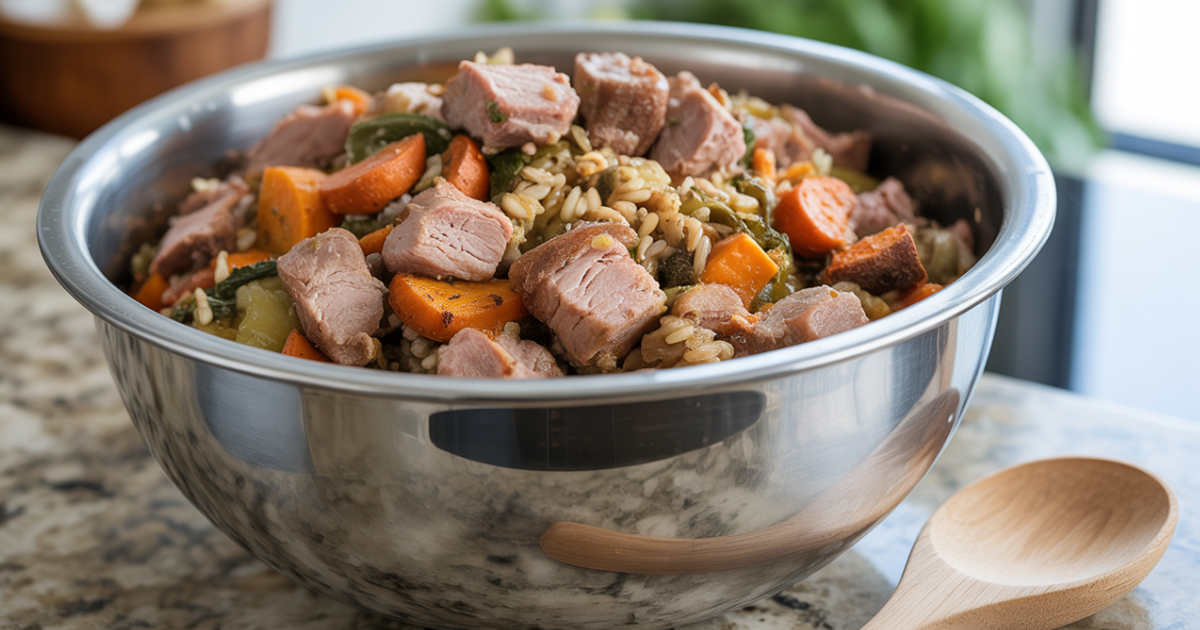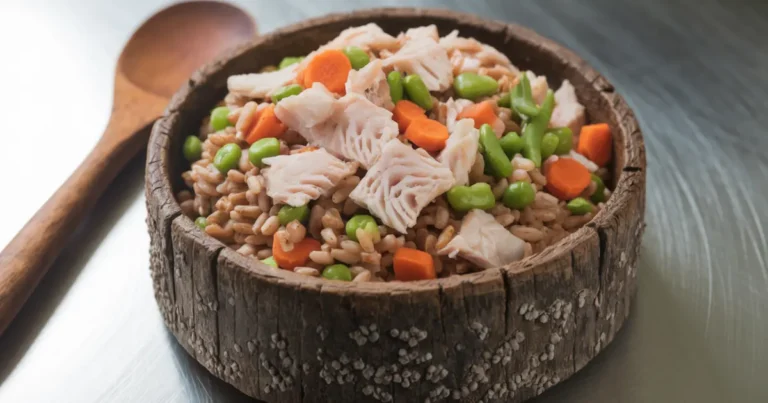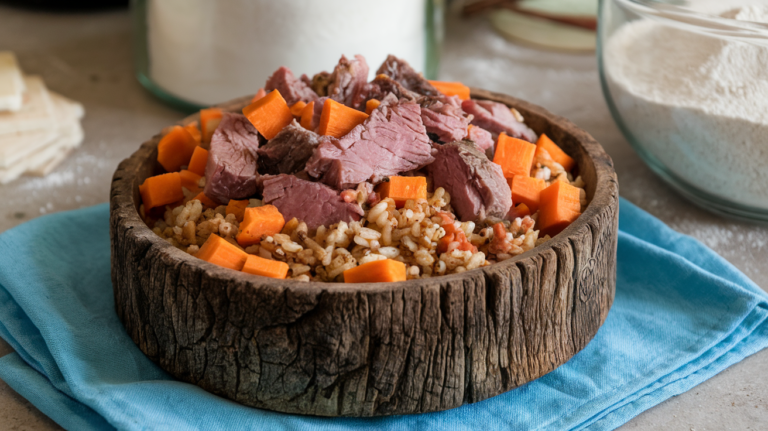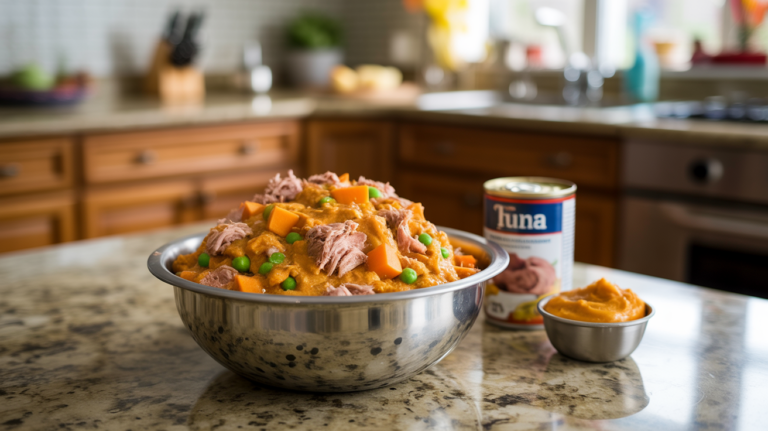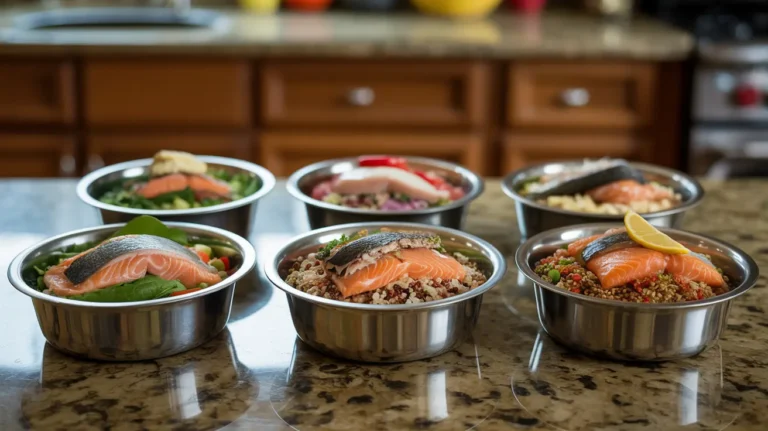Easy Pork Dog Food Recipe for Healthy Dogs
You do realize your dog deserves better than canned mystery meat? Your dog deserves better than mystery meat from a can, right? If you’ve been staring at commercial dog food labels wondering what half those ingredients actually are, you’re not alone. Making your own pork dog food recipe at home isn’t just trendy, it’s a game-changer for your pup’s health and your peace of mind.
I started making homemade pork dog food for my German Shepherd, Max, after he developed skin allergies from commercial kibble. The transformation was incredible. His coat became shinier, his energy levels improved, and those constant ear infections? Gone. Plus, cooking for Max became one of our favorite bonding activities (okay, maybe I enjoyed it more than he did, but he certainly appreciated the results :).
Table of Contents
Why Choose Pork for Your Dog’s Homemade Meals?
Pork often gets a bad rap in the dog food world, but it’s actually an excellent protein source when prepared correctly. Unlike chicken or beef, pork provides a unique amino acid profile that supports muscle development and overall health.
Benefits of pork in homemade dog food:
- High-quality protein for muscle maintenance
- High in thiamine (Vitamin B1) for the health of the nervous system
- Contains selenium for immune system support
- Good source of zinc for healthy skin and coat
- Less common allergen compared to chicken or beef
The key is choosing the right cuts and preparing them properly. Lean cuts like pork loin or tenderloin work best for DIY pork dog recipes, avoiding fatty cuts that can cause digestive upset.
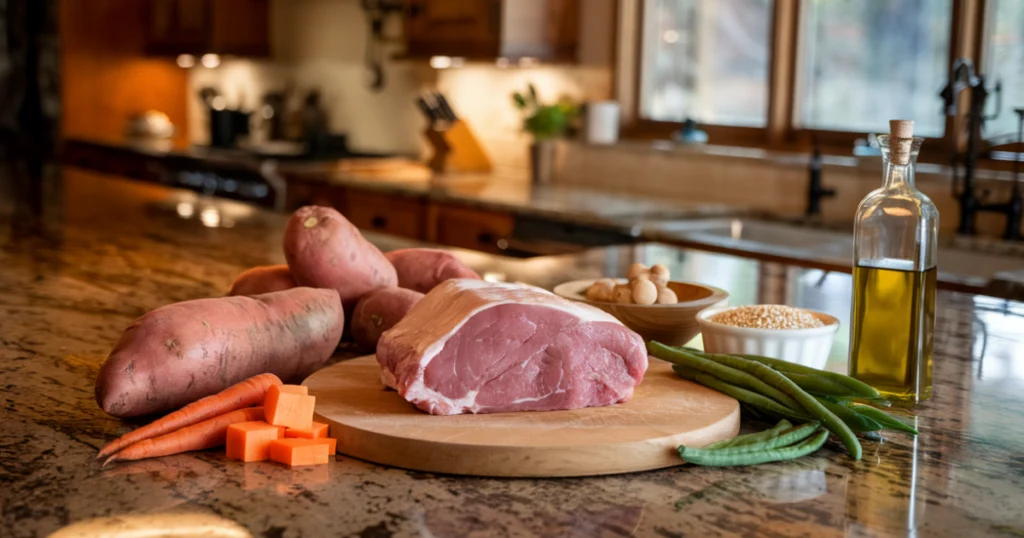
Recipe Overview
- Prep Time: 15 minutes
- Cooking Time: 45 minutes
- Total Time: 60 minutes
- Yield: 8-10 cups (enough for a 50-pound dog for about a week)
- Storage: 4 days refrigerated, 3 months frozen
- Difficulty: Easy (your dog will think you’re a gourmet chef 🙂
This recipe makes about 8–10 cups, which is enough for a week for a 50-pound dog. Adapt serving sizes to your dog’s size and level of activity.
Essential Ingredients for Healthy Pork Dog Food
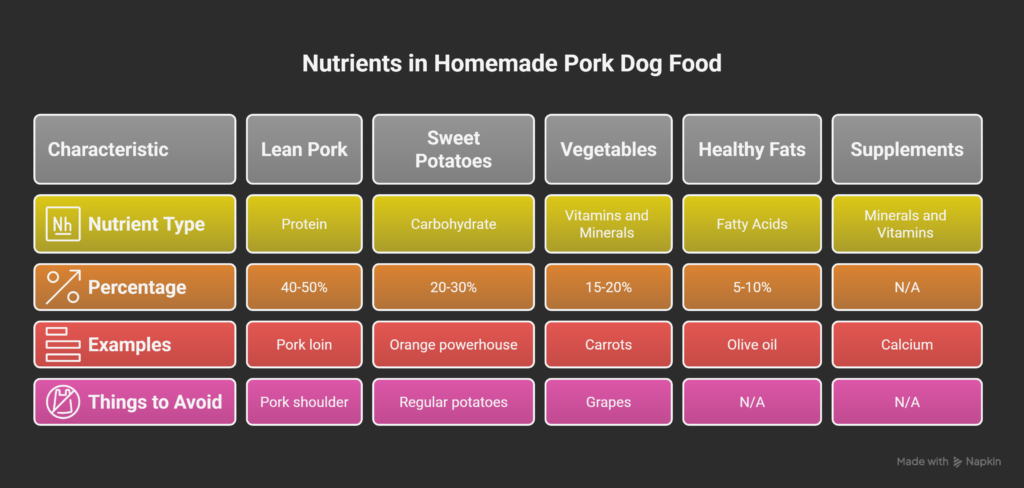
Creating balanced homemade pork dog food requires more than just throwing some meat in a bowl. Your pup needs a complete nutritional profile, and that means combining proteins, carbohydrates, vegetables, and essential supplements.
Primary Ingredients
Lean pork (40-50% of recipe): Choose pork loin, tenderloin, or lean ground pork. Steer clear of pork shoulder and ribs because they are high in fat.
Sweet potatoes (20-30%): These orange powerhouses provide complex carbohydrates, fiber, and beta-carotene. They’re easier to digest than regular potatoes and naturally sweet; most dogs love them.
Vegetables (15-20%): Carrots, green beans, and peas add vitamins, minerals, and fiber. Steer clear of grapes, onions, and garlic as they are poisonous to dogs.
Healthy fats (5-10%): A small amount of olive oil or fish oil provides essential fatty acids for coat health.
Nutritional Supplements
Don’t skip these, they’re crucial for balanced nutrition:
- Calcium supplement (calcium carbonate or bone meal)
- Multivitamin designed for dogs
- Fish oil for omega-3 fatty acids
Complete Pork and Sweet Potato Dog Food Recipe
This recipe makes about 8–10 cups, which is enough for a week for a 50-pound dog. Adapt serving sizes to your dog’s size and level of activity.
Ingredients
Protein:
- 2 pounds lean pork loin or tenderloin, cut into chunks
- 2 large eggs (optional, for additional protein)
Carbohydrates:
- 3 medium sweet potatoes, peeled and diced
- 1 cup brown rice (cooked)
Vegetables:
- 1 cup carrots, chopped
- 1 cup green beans, chopped
- 1/2 cup peas (fresh or frozen)
Supplements and Fats:
- 2 tablespoons olive oil
- 1 teaspoon calcium carbonate powder
- 1 dog multivitamin tablet, crushed
- 1 tablespoon fish oil
Step-by-Step Cooking Instructions
Step 1: Get the sweet potatoes ready. Set the oven temperature to 400°F. Arrange the chopped sweet potatoes on a baking sheet, brush them with a little olive oil, and roast them for twenty to thirty minutes, or until they are soft. This method preserves more nutrients than boiling.
Step 2: Prepare the pork. Heat a large skillet over medium heat while the sweet potatoes roast. Add pork chunks and cook thoroughly, about 15-20 minutes, stirring frequently. For pork to be free of parasites, its internal temperature must reach 145°F. No pink should remain.
Step 3: Steam the Vegetables. Steam carrots, green beans, and peas until tender but still slightly crisp, about 8-10 minutes. Overcooked vegetables lose nutritional value.
Step 4: Cook the Rice. Prepare brown rice according to package directions. Before combining it with other ingredients, let it cool fully.
Step 5: Combine and Season. In a large mixing bowl, combine cooked pork, roasted sweet potatoes, steamed vegetables, and cooled rice. Add olive oil, fish oil, and crushed supplements. Mix thoroughly to ensure even distribution.
Step 6: Final Preparation. If using eggs, scramble them separately and fold them into the mixture once cooled. The mixture should have some moisture, but not too much.
Storage and Serving Guidelines
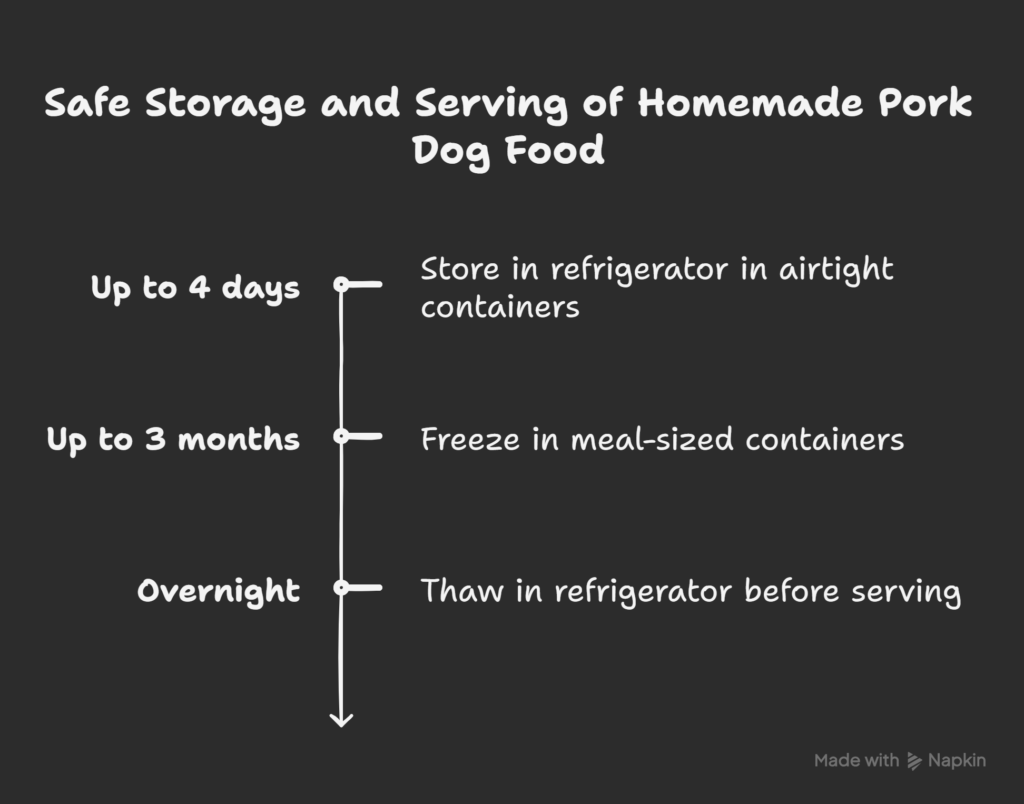
Store homemade pork dog food in the refrigerator for up to four days in airtight containers.
Freezer storage: Portion into meal-sized containers and freeze for up to 3 months. Thaw overnight in the refrigerator before serving.
Pork that is undercooked or raw may contain bacteria and parasites that are dangerous to dogs. Never serve hot food to dogs.
Portion Control and Feeding Guidelines
Determining the right amount of homemade pork dog food depends on your dog’s size, age, and activity level. Here’s a general guideline:
| Dog Weight | Daily Amount | Meals per Day |
|---|---|---|
| 10-20 lbs | 1-2 cups | 2-3 |
| 21-50 lbs | 2-4 cups | 2 |
| 51-80 lbs | 4-6 cups | 2 |
| 80+ lbs | 6-8 cups | 2-3 |
Monitor your dog’s weight and adjust portions accordingly. Active dogs need more calories, while senior or less active dogs need fewer.
Safety Considerations for Pork Dog Food
Making healthy pork dog food requires attention to food safety. Raw or undercooked pork can harbor parasites and bacteria harmful to dogs.
Critical safety tips:
- Always cook pork to 145°F internal temperature
- Wash hands and surfaces thoroughly after handling raw pork
- Use separate cutting boards for meat and vegetables
- Never feed raw pork bones—they can splinter and cause choking
- Avoid seasoned or processed pork products
Some dogs may be sensitive to pork initially. Introduce your DIY pork dog recipe gradually, mixing it with their current food over 7-10 days.
Transitioning to Homemade Pork Dog Food
Switching from commercial to homemade dog food requires patience. Sudden dietary changes can cause digestive upset, so take it slow.
- Week 1: Mix 25% homemade pork dog food with 75% of the current food
- Week 2: Increase to 50% homemade, 50% current food
- Week 3: Move to 75% homemade, 25% current food
- Week 4: Feed 100% homemade pork and sweet potato dog meal
Watch for signs of digestive issues like loose stools or vomiting. If problems persist, consult your veterinarian.
Nutritional Benefits of This Pork Dog Food Recipe
This homemade pork dog food recipe provides complete nutrition when fed as part of a balanced diet. Here’s what each ingredient contributes:
- Pork: High-quality protein containing all essential amino acids, plus B vitamins and minerals.
- Sweet potatoes: Complex carbohydrates for sustained energy, plus vitamin A for eye health and immune function.
- Brown rice: Additional carbohydrates and B vitamins, plus fiber for digestive health.
- Mixed vegetables: Antioxidants, vitamins, and minerals that support overall health.
- Olive oil: Monounsaturated fats for coat health and nutrient absorption.
- Omega-3: fatty acids from fish oil can improve joint health, reduce inflammation, and support brain function.
Cost Comparison: Homemade vs. Commercial
Making your own pork dog food recipe can be more economical than premium commercial foods, especially for larger dogs.
Estimated costs per serving (50-lb dog):
- Homemade pork dog food: $2.50-3.00 per day
- Premium commercial dry food: $3.50-4.50 per day
- Premium wet food: $5.00-7.00 per day
Initial investment in supplements and storage containers adds to upfront costs, but the long-term savings are significant. Plus, you control ingredient quality—something you can’t guarantee with commercial foods.
Customizing Your Pork Dog Food Recipe
Every dog has unique needs and preferences. You can make changes to this do-it-yourself pork dog recipe:
For senior dogs: Add glucosamine supplements and reduce portion sizes.
For active dogs: Increase protein content by adding an extra egg or more pork.
For dogs with sensitive stomachs: Remove peas and add pumpkin puree for easier digestion.
For variety: Rotate vegetables seasonally—summer squash, winter carrots, spring green beans.
Signs Your Dog Loves Their Homemade Food
You’ll know your healthy pork dog food is a hit when you see these positive changes:
- Improved coat shine and softness
- Better breath (seriously!)
- More consistent, well-formed stools
- Increased energy and playfulness
- Cleaner teeth and healthier gums
- Better weight management
IMO, the best indicator is mealtime enthusiasm. When your dog starts doing happy dances at dinner time, you know you’ve nailed it.
Final Thoughts
Creating homemade pork dog food isn’t just about nutrition; it’s about showing love through food, just like we do for our human family members. This pork and sweet potato dog meal recipe gives you control over every ingredient that goes into your dog’s bowl.
Yes, it requires more effort than opening a bag of kibble, but watching your dog thrive on food you made with your own hands? Totally worth it. Start with this basic recipe, then experiment with seasonal vegetables and different protein combinations as you both get comfortable with homemade meals.
Your dog will thank you with better health, more energy, and probably a few extra tail wags at dinner time. And honestly, isn’t that what being a dog parent is all about?
Frequently Asked Questions
Can I substitute other meats for pork in this recipe?
Absolutely! You can replace pork with chicken, turkey, or beef using the same proportions. Cooking times may vary slightly, but the nutritional balance remains similar.
How long does homemade pork dog food last in the refrigerator?
Properly stored homemade dog food stays fresh for 3-4 days in the refrigerator. Always check for off odors or texture changes before serving.
Can I give my dog pork bones?
Never feed cooked pork bones as they can splinter and cause serious injury. Raw bones are controversial—consult your veterinarian for guidance based on your dog’s size and chewing habits.
Can puppies eat this pork dog food recipe?
Puppies have different nutritional needs from adult dogs. Consult your veterinarian before switching puppies to homemade food, as they may need specialized puppy formulations.
What if my dog has food allergies?
If your dog has known food allergies, modify the recipe by eliminating trigger ingredients. Common allergens include eggs, certain grains, and specific proteins. Always introduce new foods gradually.
Do I need to add supplements to homemade dog food?
Yes, supplements are essential for nutritional balance. Calcium, multivitamins, and omega-3 fatty acids help ensure your dog receives complete nutrition that commercial foods provide through fortification.
References and Resources
For additional homemade dog food recipes and nutritional guidance, check out these helpful resources:
- 6 Best Homemade Meat Dog Food Recipes – Comprehensive guide to various meat-based homemade dog food options
- American Kennel Club Canine Nutrition Guidelines
- Association of American Feed Control Officials (AAFCO) Dog Food Nutrient Profiles
- Veterinary Nutritionist Consultation Resources
Your Dog Tried It? Drop a Review Below!
There are no reviews yet. Be the first one to write one.

